Reference: AASM (2007). The AASM Manual for the Scoring of Sleep and Associated Events: Rules, Terminology and Technical Specifications. (Westchester: American Academy of Sleep Medicine).
綠色部分來自:http://wenku.baidu.com/link?url=7DQzUI9iM74iN10GrWGvA2iWCtcliFq8zsvPoVGJ4dB16PO2JtmwYEcJUOouL6R71C3A6a7quLESI1VHsiYlzQrql0zPkL1l82qCk9wFC_W
♥ Basic knowledge
1. Stage of Sleep
- W: Wakefulness
- N1: NREM 1
- N2: NREM 2
- N3: NREM 3
- R: REM
where: NREM - Non-Rapid Eye Movement, REM - Rapid Eye Movement.
2. Scoring by Epochs
- Score sleep stages in 30 second sequential epochs commencing at the start of the study;
- Assign a stage to each epoch;
- If 2 or more stages coexist during a single epoch, assign the stae comprising the greatest portion of the epoch.
♥ Stage W
1. 定義
- α波:閉眼狀態下一系列枕葉(occipital lobe)部分8-13Hz正弦波,當眼睛睜開時減弱;
- 眨眼:睜眼或閉眼的清醒狀態下,頻率為0.5-2Hz的成對垂直眼動(conugate vertical eye movement);
- 閱讀眼動資訊:被試閱讀時,出現一系列由一個慢相位緊接著一個反方向快相位組成的成對眼部活動;
- 快速眼動(REM):成對的、不規律的、尖峰的眼部活動,其起始偏差通常持續500ms以下。由於快速眼動通常也是R睡眠階段的特徵,它們也可以在被試清醒狀態下環顧四周的情況下見到。
2. 判定規則
- More than 50% of the epoch has aloha rhythm over the occipital region;
- If any of the following are present without visually discernable α rhythm:
A. Eye blinks at a frequency of 0.5-2 Hz;
B. Reading eye movements;
C. Irregular conjugate rapid eye movements associated with normal or high chin muscle tone.
- 枕區α節律佔記錄幀50%以上判讀為W期;
- α節律沒有出現在記錄幀,但存在下列特徵之一者,判讀為W期:
A. 頻率在0.5 – 2Hz的眨眼動作;
B. 閱讀眼動;
C. 不規則的共軛快速眼動伴正常或增強的頦肌電。
3. 注意
- W階段出現在喚醒狀態(包括從完全清醒到睏倦的早期階段)。睏倦的電生理和精神生理標誌可能出現在W階段,並一直持續到N1階段;
- 在W階段,閉眼狀態下,大部分閉眼被試呈現α波。睜眼狀態下,EEG由低幅活動活動組成(主要為β頻率和α頻率),而沒有alpha波節律性。大約10%閉眼被試不表現任何α波,另外10%只表現出有限的α波。在這些被試中,枕葉(occipital)EEG活動在睜眼和閉眼的時候呈現相似規律;
- 清醒狀態下,眼電圖(electro-Oculogram, EOG)可能呈現大概0.5-2Hz的眨眼頻率。睏意增長時,眨眼頻率降低,並且眨眼可能會被緩慢眼動代替(甚至是在連續α波存在的情況下)。在睜眼情況下,可能見到自發眼動或閱讀眼動。
- 在W階段,下巴肌電圖(electromyography,EMG)的波幅變化很大,但通常高於睡眠階段。
♥ Stage N1
1. 定義
- 慢眼動(slow eye movement,SEM):成對、較規則的(reasonably regular)、正弦狀眼動,起始偏差通常持續500ms以下;
- 低振幅,多種頻率活動:低振幅,主要為4-7Hz活動;
- 頂尖波(vertex sharp waves,V waves):中心區域出現的鋒利輪廓的波形,最多持續0.5秒,顯著區別於背景活動;
- 睡眠起始:是除了W階段以外的任何階段的第一個時段(epoch)。(對大多數被試來說,這通常是N1階段的第一個時段)。
2. 判定規則
- In subjects who generate α rhythm, score stage N1 if α rhythm is attenuated and replaced by low amplitude, mixed frequency activity for more than 50% of the epoch;
- In subjects who do not generate α rhythm, score stage N1 commencing with the earliest of any of the following phenomena:
A. Activity in range of 4-7 Hz with slowing of background frequencies by ≥1 Hz from those of stage W;
B. Vertex sharp waves;
C. Slow eye movements.
- 有α節律者,如α節律減弱並被低波幅混合頻率活動取代,且後者佔一幀的50%以上,判讀為N1期;
- 無α節律者,呈現下列現象之一時,判讀為N1期:
A. 較W期腦電背景頻率減慢≥1Hz的4-7Hz腦電波;
B. 頂尖波;
C. 緩慢眼動。
3. 注意
- 頂尖波可能會在N1階段出現,但不是判定N1階段的必要條件;
- 眼電圖常常在N1階段中顯示慢眼動,但不是判定N1階段的必要條件;
- N1階段中,下巴肌電圖振幅多變,但通常低於W階段;
- 儘管慢眼動通常會在α波開始減弱前開始,但對於那些不產生α波的被試來說,睡眠潛伏期通常會比產生α波的被試稍微短一點。
♥ Stage N2
1. 定義
- K複合波(K complex):去線性負尖波,緊跟著一個顯著區別於背景EEG的正性成分,總共持續超過0.5秒,通常在使用frontal derivations(?)記錄的時候振幅達到最大。一個和K複合波相關的喚起必須在K複合波結束之後的一秒內開始。
- 睡眠紡錘波(sleep spindle):一系列頻率在11-16Hz(12-14Hz內最常見)的獨特波形,持續超過0.5s,通常使用central derivations時振幅最大(usually maximal in amplitude using central derivations)。
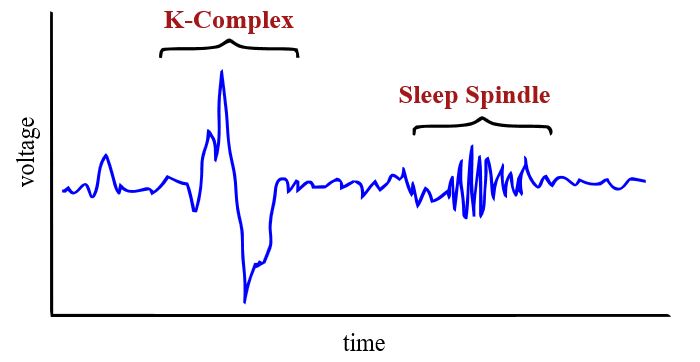
(Pic source: https://en.wikipedia.org/wiki/K-complex)
2. 判定規則
- Begin scoring stage N2 (in absense of criteria for N3) if one or both of the following occur during the first half of that epoch or the last half of the previous epoch:
A. One or more K complexes unassociated with arousals;
B. One or more trains of sleep spindles.
Note:
A. Continue to score stage N1 for epochs with arousal-associated K complexes but bi spontaneous K complexes or sleep spindles;
B. For the purposes of scoring N2 sleep, arousalsa are defined according to arousal rule V.1.
- The rule defines continuation of a period of stage N2 sleep: continue to score epochs with low amplitude, mixed frequency EEG activity without K complexes or sleep spindles as stage N2 if they are preceded by a) K complexes unassociated with arousals or b) sleep spindles.
- End stage N2 sleep when one of the following events occurs:
A. Transtition to stage W;
B. An arousal (change to stage N1 until a K complex unassociated with an arousal or a sleeo spindle occurs, see Figure 1);
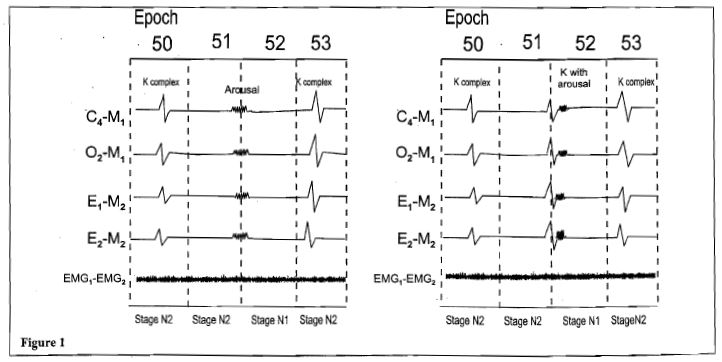
C. A major body movement followed by slow eye movement and low amplitude mixed frequency EEG without non-arousal associated K complexes or sleep spindles (score the epoch following the major body movement as stage N1; score the spoch as stage N2 if there are no slow eye movements; the epoch containing the body movement is scored using criteria in Section 8; see Figrue 2);
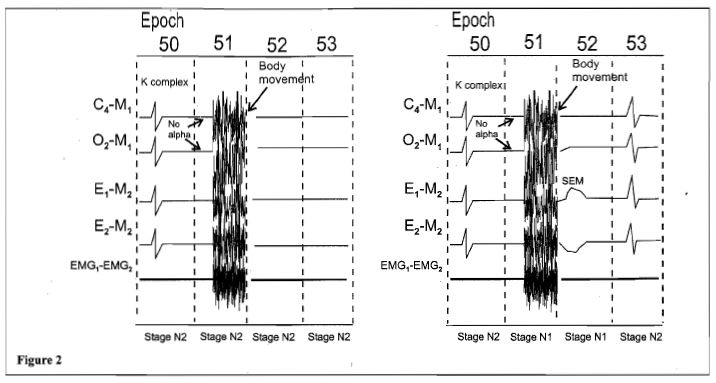
D. Transition to stage N3;
E. Transition to stage R.
- N2期睡眠起始判讀規則:
如果判讀幀前半幀或前一幀的後半幀存在與覺醒無關的K複合波、睡眠梭波,判讀為N2期間開始(不符合N3期標準);
- N2期睡眠持續判讀規則:
數幀不含K複合波或睡眠梭波的低波幅混合頻率腦電活動,如果此前存在:① 非覺醒相關性K複合波或② 睡眠梭波,繼續判讀為N2期;
- N2期睡眠終止判讀規則:
出現以下事件之一,判讀為一段N2期結束:
A. 轉為W期;
B. 一次覺醒轉為N1,直到出現非覺醒相關性K複合波或睡眠梭波(見下圖);
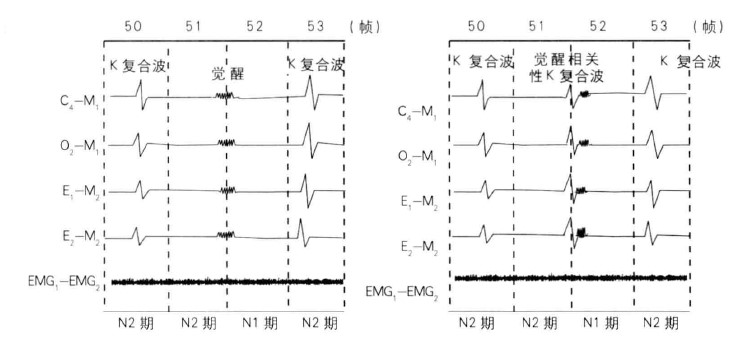
C. 一次大體動伴隨緩慢眼動和低波幅混合頻率腦電沒有非覺醒相關性K複合波或睡眠梭波(大體動之後記錄幀判讀為N1期;如果沒有緩慢眼動判讀為N2期;含大體動記錄幀判讀規則見大體動部分)(見下圖);
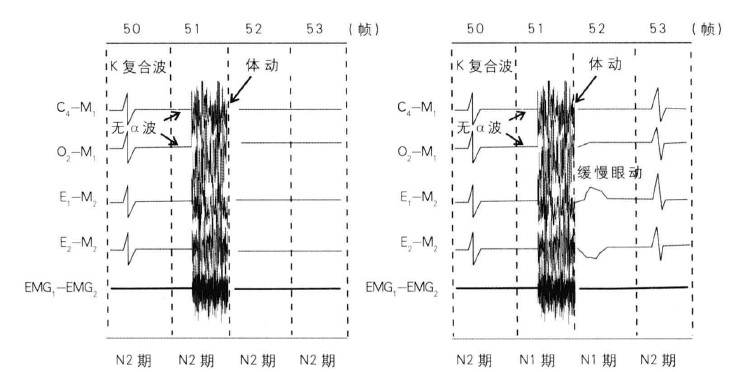
- 轉為N3期;
- 轉為R期。
3. 注意
- 眼電圖通常在N2階段不表現任何眼部活動,但是慢眼動也許會在某些被試中存在;
- 在N2階段,下巴肌電圖振幅多變,但通常比W階段低,並可能低至和R階段相仿。
♥ Stage 3
1. 定義
慢波活動:頻率在0.5-2Hz之間,峰對峰振幅大於75微伏,在頭部前側區域測量得到的波形。
2. 判定規則
一個時段(epoch)內大於等於20%的時間由慢波活動組成,與年齡無關。
當慢波活動佔一幀的20%以上時判讀為N3,不用考慮年齡因素。
3. 注意
- 睡眠紡錘波可能持續到N3階段;
- 眼動不常見於N3階段;
- 在N3階段,下巴肌電圖振幅多變,通常低於N2階段,有時會低至與R階段相近水平。
♥ Stage R
1.定義
- 快速眼動(rapid eye movement,REM):成對的、不規律的、尖峰眼動,起始偏差持續小於500毫秒;
- 低下巴肌電圖(low chin EMG tone):下巴肌電活動基線低於其他任何睡眠階段,通常是整個記錄中的最低水平;
- 鋸齒波(sawtooth waves):一系列鋸齒狀、或三角形,2-6Hz的波形,其最大幅值出現在頭部中央區域(central head regions),並且常常(並不總是)在快速眼動爆發過後出現;
- 瞬時肌肉活動(transient muscle activity):肌電圖活動短期不規則爆發,通常持續時間小於0.25秒,疊加在肌電圖低值部分(superimposd on low EMG tone)。該活動可以在下巴或前脛骨肌電圖偏差、腦電圖和眼電圖偏差中看到,後者表示受腦神經支配肌肉的活動(activity of cranial nerve innervated muscles)。該活動在快速延東起達到最大。
2. 判定規則
- Define a epoch as stage R sleep with all the following phenomena:
A. Low amplitude, mixed frequency EEG;
B. Low chin EMG tone;
C. Rapid eye movements.
- The rule defines the continuation of a period of stage R sleep:
Continue tou score stage R sleep, even in the absence of rapid eye movements, for epochs following one or more epochs of stage E as defined above, if the EEG continues to show low amplitude, mixed frequency activity without K complexes or sleep spindles and the chin EMG tone remains low (Figure 3).
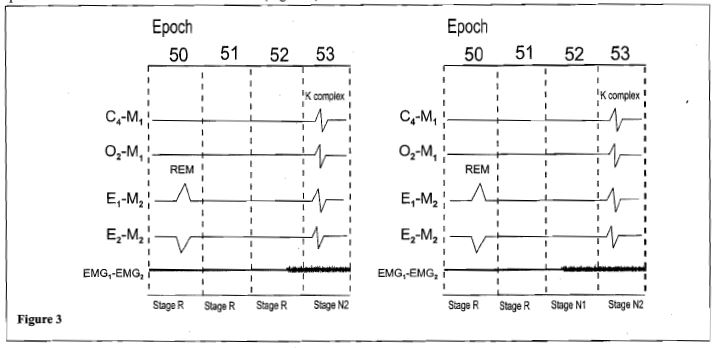
- The rule defined the end of a period of stage R sleep (when one or more of the following occur):
A. transition to stage W ro N3;
B. An increase in chin EMG tone above the level of stage R is seen and criteria for stage N1 are met (Figure 4);
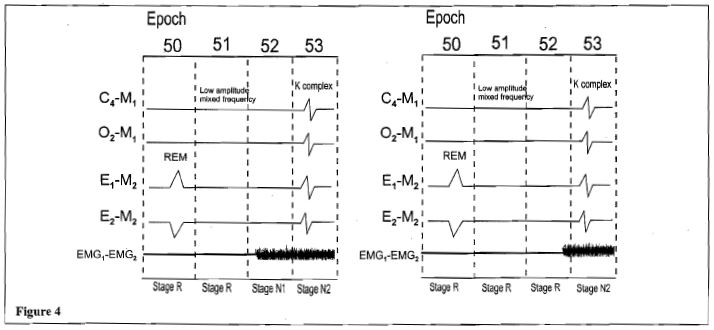
C. An arousal occurs followed by low amolitude, mixed frequency EEG and slow eye movements (scored as stage N1; if no slow eye movements and chin EMG tone remains low, continur to score as stage R; Figrue 5);
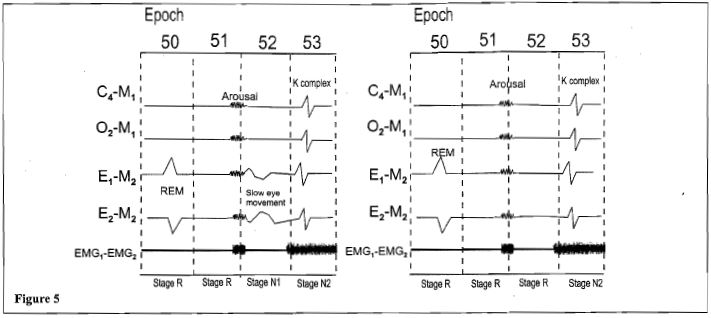
D. A major body movement followed by slow eye movements and low amplitude mixed frequency EEG withou non-arousal associated K comolexed or sleep spindles (score the epoch following theas stage N1; if no slow eye movements and the EMG tone remains low, continue to score as stage R; the epoch containing the body movement is scored using criteria in body section; Figrue 6);
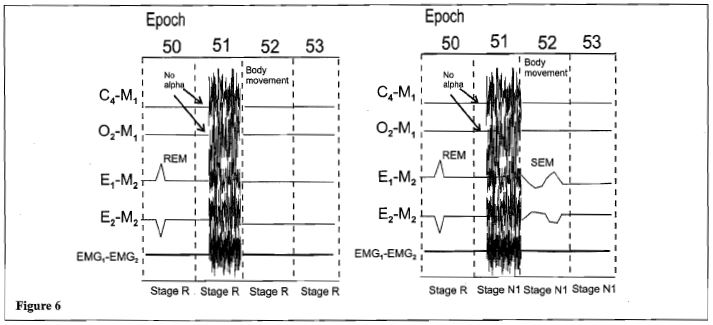
E. One or more non-arousal associated K comolexed or sleep spindles are present in the first half of the epoch in the absense of rapid eye movements, even if chin EMG tone remains low (scored as stage N2; Figure 7).
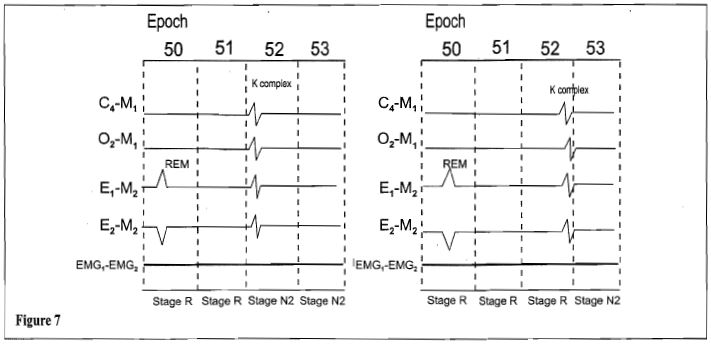
- Score epochs at the transition between stage N2 and stage R as follows:
A. In between epochs of definite stage N2 and definite stage R, score an epoch with a distinct drop in chin EMG in the first half of the epoch to the level seen in stage R as stage R if all of the following criteria are met, even in the absence of rapid eye movements (Figrue 8):
.. Absense of non-arousal associated K complexes;
.. Absense of sleep spindles.
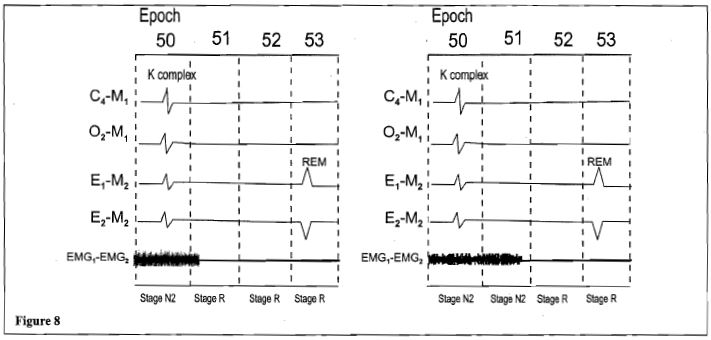
B. In between epochs of definite stage N2 and definite stage R, score an epoch with a distinct drop in chin EMG in the first half of the epoch to the level seen in stage R as stage N2 if all of the following criteria are met, even in the absence of rapid eye movements (Figrue 9A):
.. Presence of non-arousal associated K complexes or sleep spindles;
.. Absencce of rapid eye movements.
C. In between epochs of definite stage N2 with minimal chin EMG tone and defimite stage R without further drop in chin EMG tone, score epochs as stage R if all of the following are met, even in the absence of rapid eye movements (Figure 9B):
.. Absence of non-arousal associated K complexes;
.. Absence of sleep spindles.
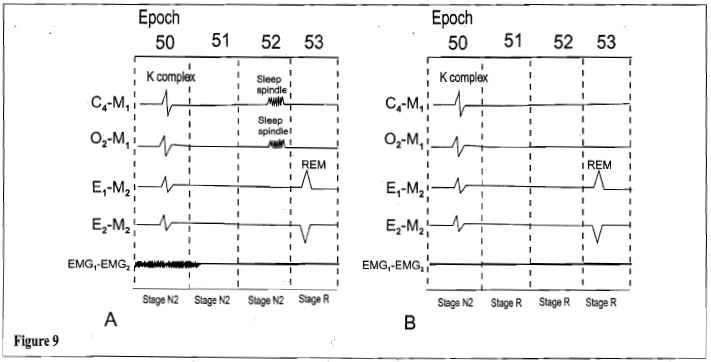
- 記錄幀呈現下列所有現象時判讀為R期:
A. 低波幅混合頻率腦電波;
B. 低張力頦EMG;
C. 快速眼動。
- R期睡眠持續判讀規則
對於符合上述A項判讀規則的一幀或多幀R期,其後連續數幀無快速眼動,此時如果EEG持續顯示為低波幅混合頻率活動,沒有K複合波或睡眠梭形波,而且頦肌電張力仍低,判讀為R期(如下圖);
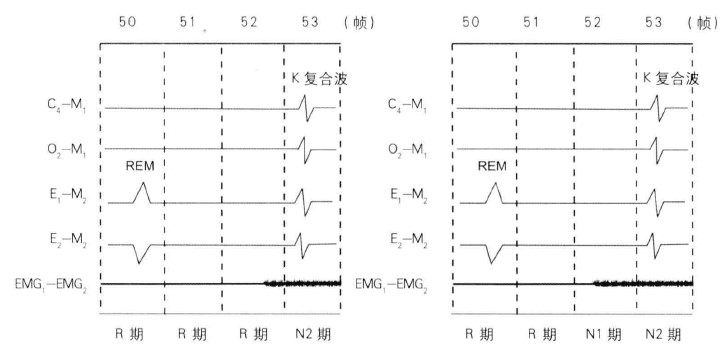
- R期睡眠終止判讀規則
發生下列一項或一項以上時判讀為R期終止:
A. 轉為W期或N3期;
B. 頦肌電張力增加高於R期水平,並且符合N1期標準(如下圖);
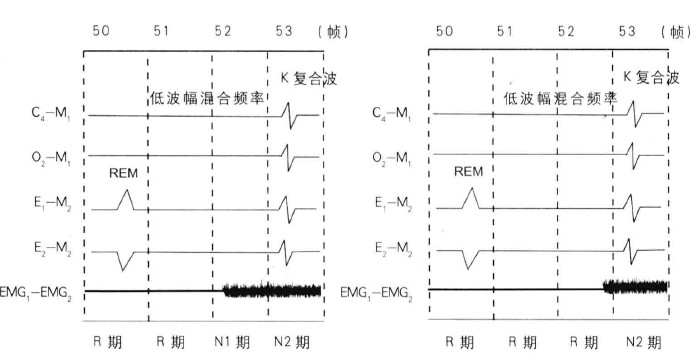
C. 覺醒後出現低波幅混合頻率腦電和緩慢眼動(判讀為N1期,如果無緩慢眼動並且頦肌電仍低則繼續判讀為R期)(如下圖圖);
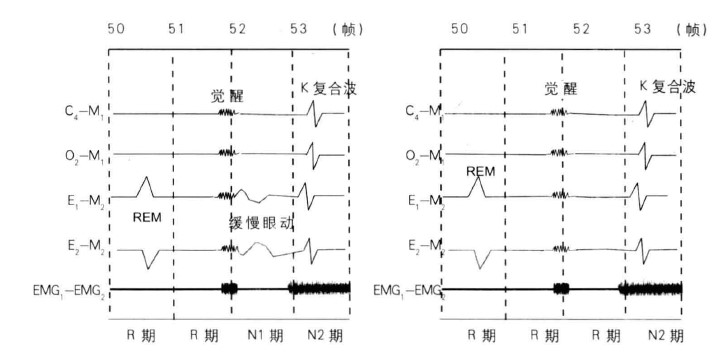
D. 大體動後出現緩慢眼動和低波幅混合頻率腦電,沒有非覺醒相關性K複合波或睡眠梭形波(大體動隨後幀判讀為N1期,如果無緩慢眼動並且頦肌電仍低,持續判讀為R期。含大體動幀判讀標準見大體動部分)(如下圖);
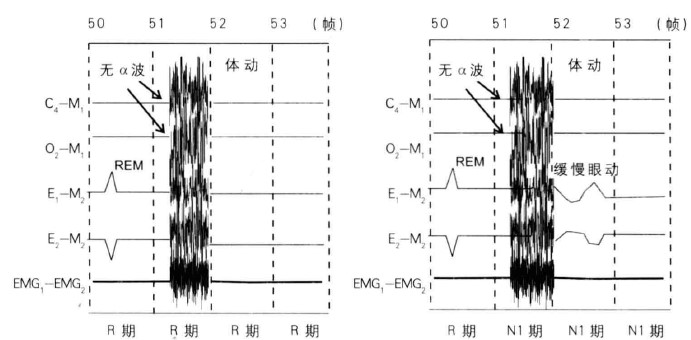
E. 一或多個非覺醒相關性K複合波或睡眠梭形波,呈現在沒有快速眼動記錄幀的前半部分,即使頦肌電張力仍低也判讀為N2期(如下圖)。
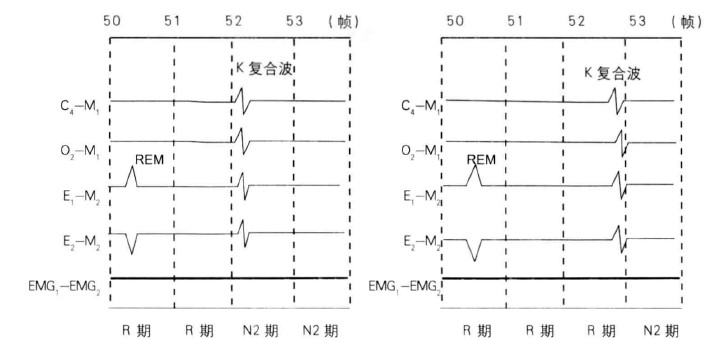
- N2期和R期間轉化判讀規則
A. N2期和R期間連續數幀記錄中,若某一幀前半部頦肌電明顯減低達到R期水平,並無非覺醒相關性K複合波及睡眠梭形波,即使無快速眼動,也判讀此幀為R期(如下圖);
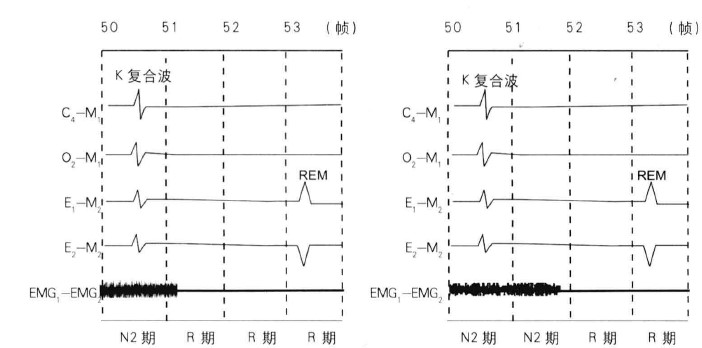
B. N2期和R期間連續數幀記錄中,若某一幀的前半部頦肌電明顯減低達到R期水平,同時存在非覺醒相關性K複合波或睡眠梭形波並無快速眼動,判讀為N2期(如下圖);
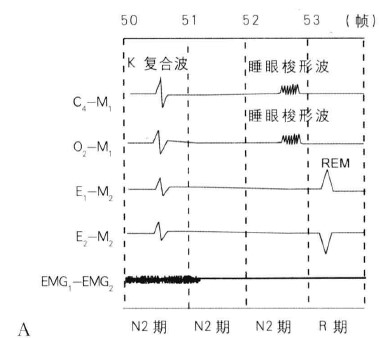
C. N2期和R期間連續數幀記錄中,如果頦肌電已在N2期下降到最低點並且在隨後的記錄幀中沒有進一步下降,若無非覺醒相關性K複合波及睡眠梭形波,即使無快速眼動,也判讀為R期(如下圖)。
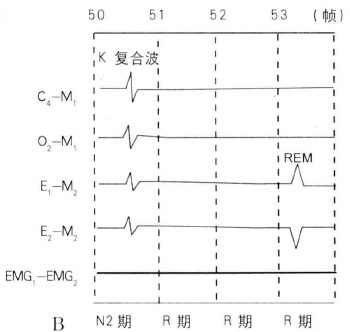
3. 注意
- R階段低振幅,混合頻率活動和N1階段的很相似。在某些被試中,R階段可以看到比N1階段更多的α波。R階段中的α波通常比清醒狀態慢1-2Hz;
- 在判定階段困難時,出現以下兩種現象對判定為R階段有很強支援作用:
A. 鋸齒波;
B. 瞬時肌肉活動(R階段中雖然會出現鋸齒波和瞬時肌肉活動,但他們並不是判定R階段的必要條件)。
- 有時,尤其是在夜間的第一個REM睡眠時期,K複合波或睡眠紡錘波可能在其中零散出現,而該時段可能並不是R階段(K complexes or sleep spindles may be interspersed among epochs of what otherwise appears to be stage R sleep)。以上規則表明,出現快速眼動的時段,即使有K複合波或紡錘波出現,也應當判定為R階段。然而, 如果快速眼動不出現,之後出現K複合波或紡錘波的時段應當被判定為N2階段;及時下巴肌電圖值較低(chin muscle tone remains low)。
♥ 大體動(Major body movements)
1. 定義
活動及肌肉偽跡(muscle artifact)導致EEG訊號在一個時段內超過半數時間模糊不清,無法判定睡眠階段。
身體運動和肌電干擾佔據記錄幀的50%以上,使該幀難以判讀睡眠分期。
2. 判定規則
- If α rhythm si present for part of the epoch (even <15 seconds duration), score as stage W;
- If no α rhythm is discernable, but an epoch scorable as stage W either precedes or follows the epoch with a major body movement, score as stage W;
- Otherwise, score the epoch as the same stage as the epoch that follows it.
- 如果此記錄幀部分含有α節律,判讀為W期。
- 如果不存在可辨的α節律,但大體動幀之前或隨後記錄幀可判讀為W期,則該幀也判讀為W期。
- 其他情況下,此幀睡眠分期判讀與其隨後一幀相同。
♥ 覺醒(Arousal)
1. 判定規則
在N1、N2、N3或R階段,如果EEG頻率(包括α、θ或/及其他超過16Hz但並不是紡錘波的頻率)發生突變,該突變持續至少3秒且在該突變之前有超過10秒的穩定睡眠,則判定為覺醒(arousal)。
2. 注意
- 喚醒的判定應該綜合枕葉(occipital)和中央偏差;
- 喚醒的判定方法可以利用記錄中的額外資訊進行改善,例如呼吸以及/或額外的EEG通道。然而,喚醒的判定不能單獨基於這些額外資訊,這些資訊也不能改變喚醒判定規則。
♥ 呼吸暫停
- 事件持續時間判讀規則:
A. 判讀呼吸暫停或低通氣,測量事件持續時間,是從第一個波幅明顯下降呼吸曲線的最低點到波幅接近基線呼吸的第一個呼吸曲線始點止這一段時間(水平大括號);
B. 基線呼吸暫停確定困難,也可根據呼吸幅度明顯穩定增加,或在已經出現血氧飽和度減低的基礎上事件相關的血氧飽和度增加至少2%,判讀為事件終止。
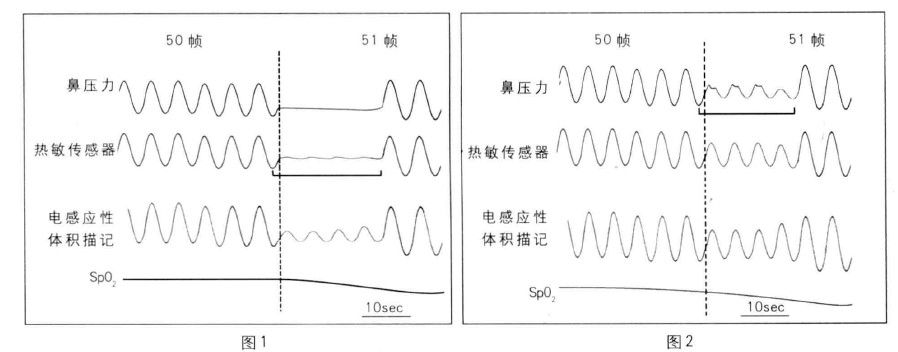
- 呼吸暫停判讀
滿足下列所有標準時判讀為一次呼吸暫停(如下圖):
A. 熱敏感測器檢測到呼吸氣流曲線峰值下降≥90%基線值;
B. 事件持續時間至少10秒;
C. 至少90%事件持續期間內,呼吸氣流波幅減低符合呼吸暫停標準。
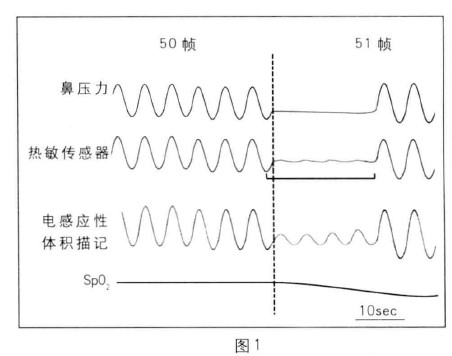
- 低通氣規則
A. 滿足下列全部標準判讀為一次低通氣(如下圖):
.. 鼻壓力訊號幅度(或替代低通氣感測器訊號幅度)下降≥30%基線值;
.. 一次下降持續時間至少10秒;
.. 血氧飽和度較事件前基線值下降≥4%;
.. 至少90%事件持續期間內,呼吸波幅減低必須符合低通氣標準。
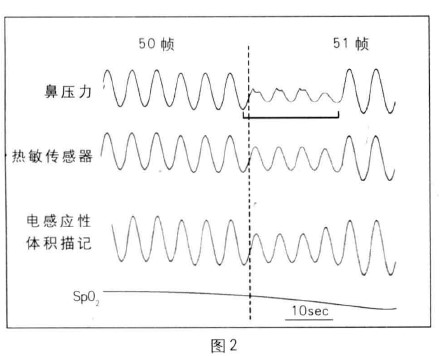
B. 滿足下列全部標準判讀為一次低通氣:
.. 鼻壓力訊號下降≥50%基線值;
.. 一次下降持續時間至少10秒;
.. 血氧飽和度較基線值下降≥3%,或事件與微覺醒有關;
.. 至少90%事件持續期間內,呼吸波幅下降必須符合低通氣標準。